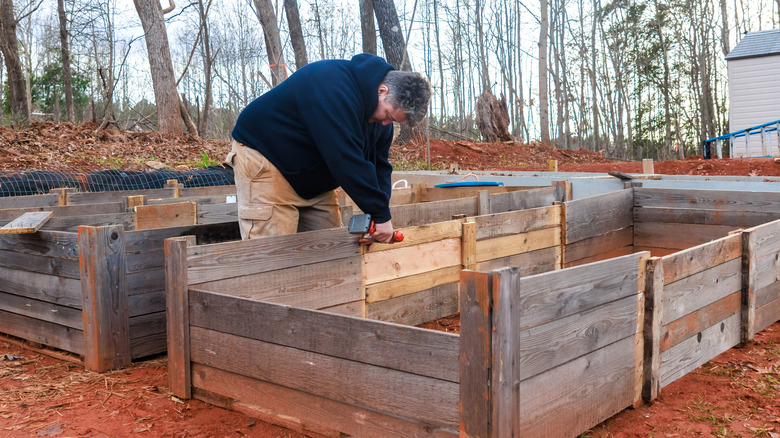Why Winter Might Be The Best Time To Build Garden Beds
When temperatures drop and daylight wanes, our pace slows, we hunker down inside, and we do our best to stay warm and dry. Gardeners often follow that same pattern, perhaps doing only light pruning or tending to structural needs around the garden while the ground is hard and plants are dormant. However, if you've been intending to build a garden bed, don't store away your tools and gloves just yet. The slower season may actually be the best time for this project.
While there's no right or wrong time to build a garden bed, House Digest's garden editor and in-house master gardener, Tiffany Selvey, shared exclusively with House Digest that constructing garden beds in the winter actually has several distinct advantages.
"Perhaps the primary advantage is the availability of organic materials to add to your new bed that will eventually break down, adding nutrients and humus to the soil," Selvey said. This is good news for gardeners who are thinking twice about using their own soil for raised garden beds but also don't want to spend too much money to fill their beds.
Finding materials for your garden bed
To fill up your garden bed, start with what's available in your yard. Look for leaves that you haven't raked (procrastinating pays off!) or branches that were recently pruned or fell during winter storms. "Placing layers of cardboard, branches, and lots of leaves can take up a lot of space, so you'll have to buy less soil and amendments," Tiffany Selvey suggested in an exclusive interview with House Digest. "You can even add some wood ash, but only do so in limited quantities. Ash is a good source of potassium, but adding too much at a time can create a soil environment that's too alkaline for most plants to thrive."
Another benefit of tackling this project in the winter is the cost and availability of materials needed for your garden bed, if you're building one from scratch. Whether you're considering one of these five common materials that you can use for DIY raised garden beds or something completely different, you won't be fighting with other gardeners in the aisles of your local hardware store.
"If you wait until March or later when everyone else has been bitten by the gardening bug, you may find these materials are more expensive or harder to find," said Selvey.
Preparing garden beds for spring planting
While you're getting ahead of other gardeners, you're also getting ahead of nature, which has its own pace and often sneaks up on us. How many of us have grown complacent with our outdoor checklist only to find that we missed the planting window for the season? By building your garden bed in the winter, you no longer need to scramble because you have plants waiting to get in the ground.
"Getting this head start removes the need to stress about getting everything done on time," Tiffany Selvey said in an exclusive interview with House Digest. "If you build your beds in the winter, they're ready for you when it's time to plant spring crops."
Once you construct your garden bed, you may realize that working outside in this frigid season actually is invigorating, especially when the sun is shining. If you can't wait until the spring to begin planting, here are some tips for starting a backyard winter garden.


